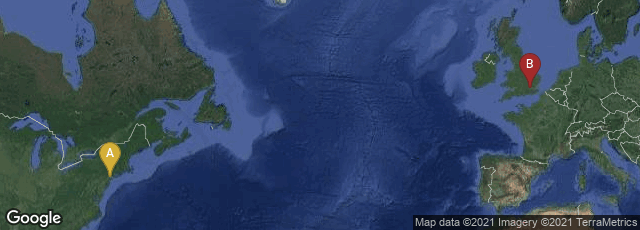
A: Manhattan, New York, New York, United States, B: London, England, United Kingdom
In 1909 William D. Weaver published Catalogue of the Wheeler Gift of Books, Pamphlets, and Periodicals in the Library of the American Institute of Engineers.With Introduction, Descriptive and Critical Notes by Brother Potamian. This 2-volume work, which remains the most comprehensive historical bibliography on electricity, magnetism and telegraphy, described primarily the library of Latimer Clark, a British electrical engineer and inventor working in London who, in partnership with Sir Charles Tilson Bright, was responsible for laying many of the first submarine telegraphic cables. While pursuing a remarkably successful and creative scientific and entrepeneurial career, Clark also found time to build one of the most complete collections ever formed of early books and manuscripts on the history of electricity and magnetism, including virtually every known publication in English on these subjects prior to 1886.
In collecting the history of electricity and telegraphy Clark followed in the path of Francis Ronalds, another telegraphy pioneer who assembled a somewhat smaller library on the subjects, the catalogue of which appeared in 1880. Nearly coincident with the publication of the catalogue of the Ronalds Library, in 1881 Francesco Rossetti and Giovanni Cantoni issued Bibliografia Italiana di Elettricità e Magnetismo, on the occasion of an international fair on electricity held in Paris in 1881. This briefly annotated bibliography presented the history of the Italian literature on the subject.
In 1901 Clark's library was purchased by the American engineer, Schulyer Skaats Wheeler, and donated by him to the American Institute of Electrical Engineers (now Institute of Electrical and Electronics Engineers [IEEE]) in New York. The extensively annotated and illustrated catalogue of the collection of 5,966 items, edited by William Weaver and annotated by Brother Potamian, was financed by Andrew Carnegie. Though the title page of the catalogue takes no notice of it, a high percentage of the items in Clark's library, particularly the final 2000 items, concern telegraphy.
♦ Problematic Management of the Latimer Clark Library in the Twentieth Century:
"In 1913 the Engineering Societies Library was established in New York City, a joint venture of the AIEE, the ASME (Mechanical Engineers), and the AIME (Mining Engineers), funded by a $1.5 million gift from Andrew Carnegie. The AIEE’s main contribution to the Library was the Wheeler Gift Collection. For many years the collection was accessible according to the terms above, but in the 1990s the ESL decided that it could no longer maintain its Manhattan premises and closed the library there.
"By that time the Wheeler Gift Collection had been merged with other works at the library, and had suffered from neglect over the years, much of the material being kept in poor physical conditions. A 1985 survey of the collection showed about 9% (532 items) were missing, and it seems unlikely that the situation improved in the following ten years, prior to the dispersion of the collection.
"Constrained by the terms of the Gift to keep the collection in New York City, the ESL boxed up whatever could be definitely identified as part of the original Wheeler Gift and in 1995 sent 205 cartons of books and papers to the Humanities and Social Sciences division of the New York Public Library at 42nd Street. The rest of the collection, including items in the 1909 catalog that were part of the Wheeler Gift but did not have identifying labels, went to Linda Hall Library in Kansas City, MO"(http://atlantic-cable.com/CablePioneers/LatimerClark.htm, accessed 07-31-2009).
Hook & Norman, Origins of Cyberspace (2001) No. 211.